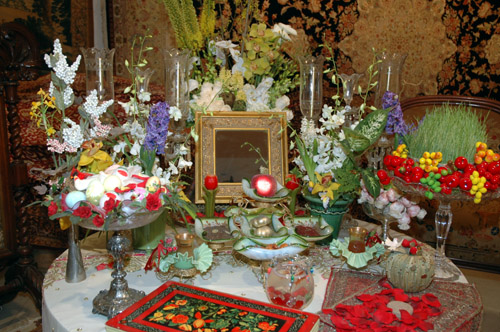
|
IRAN HERITAGE FOUNDATION NOROUZ | Background The festival of Norouz represents a major part of the Iranian peoples rich culture and is one of the cornerstones of the eastern civilisations. The origins of Norouz (New Day) are unknown, but references to it can be traced back to several thousand years predating the Achaemenid Dynasty (ca. 700 to 330 BC). The ancient Iranians marked the last ten days of the solar year in a solemn ceremony of mourning ('Farvardgan') to signify the end of life. This was followed by the festival of Norouz that in contrast celebrated the rebirth of nature, signifying the rebirth of life and this was a great occasion for celebration and joy. The details of Norouz ceremonies during the reign of the Achaemenid kings are not known, possibly because until the time of Alexander the Great foreigners were barred from attending these occasions. However, there is no shortage of references to the rituals of celebrating the Norouz during and after the reign of the Sasanian Dynasty (226 - 652 AD). One of the rock reliefs of the staircases in Persepolis depicts a procession of Median dignitaries on their way to the festival of Norouz, carrying ceremonial and symbolic offerings. The basis of the rituals have remained remarkably intact for several thousand years, observed by vast populations living in Iran, Turkey, Iraq, Afghanistan and Central Asia, as well as ex-pat communities living through out the world. The significant moment that starts the celebrations is when the earth goes through the spring equinox i.e. the exact moment when the earth has completed one revolution of the Sun, which is calculated with split second accuracy. The Zoroastrians of ancient Persia celebrated the creation of life by offering their god, Ahura Mazda, seven trays filled with symbolic objects representing truth, justice, good thoughts, good deeds, virtue, prosperity, generosity and immortality. Today, the tradition is continued through the setting of a special table or spread with an arrangement of specific symbolic items, seven of which have names that start with the Persian letter Seen (s). These are:
 Sabzeh - Wheat or lentils grown in a tray or dish prior to Norouz to represent rebirth. Samanu - A sweet pudding made from wheat germ, symbolising affluence. Senjed - The dried fruit of the lotus tree which represents love. Seer - Meaning garlic in Persian, and represents medicine. Seeb - Meaning apple in Persian, and represents beauty and health. Somaq - Sumac berries, which represent the colour of the sun rise. Serkeh - Meaning vinegar in Persian, and represents age and patience. Sonbol - The hyacinth flower with its strong fragrance heralding the coming of spring. Sekkeh - Coins representing prosperity and wealth.  Back to top Back to top Front Page Front Page |